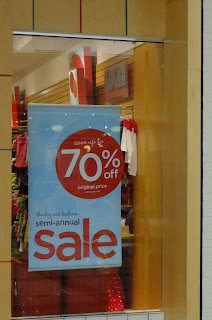The mall is a place of promise; it offers us everything we don’t
already have and at SALE PRICE!!! That is how much the stores “love” us, “understand”
us. They are willing to lower their prices in these hard times in order to
fulfill our “needs”. Of course, this is
an exaggeration, as most products are overpriced in the first place. But that
was the vibe I received while walking through the mall. I was always aware of
the fact that stores tried to convince customers to buy their products through
advertisement, but I never realized how subtle these advertisements can be, how
much they appealed to a deeper human nature, and how they actually affected me.
It is so easy to get pulled into the
consumerist mindset if you are not really paying attention. During my
experience at the mall, I was stunned by how drawn I was to enter various
stores, even if it was just to look at a product on display. Thankfully, with
my newfound awareness, I was able to resist purchasing anything, but I was
acutely aware of the profound effect that the stores had on me. I wanted to buy
something, even though my intentions of coming to the mall were purely academic.
Looking at the motivation behind my unintentional desire to
purchase goods, I would argue that the advertisements in the mall were all
directed toward making me feel like I should buy the product now, before the
sale/deal ended. I felt obligated to purchase a product because I felt like the
store was doing me a favor by lowering the price, even though I know intellectually
that is not the case. This effect of advertisements using the consumer to
convince themselves to by the product was noted in the video, The Persuaders.
In addition, I was
drawn to the setting and atmosphere the mall produced. Ironically enough, the
mall was called Woodland, which automatically makes it sound like a natural and
organic place, even though it is the exact opposite. The theme of the mall was
leaves and trees (obviously) and there were multiple fake trees and artwork of
leaves scattered frequently throughout the mall. This, combined with very high
ceilings and skylights, gave me the feeling of being in a forest or garden, which
was mentioned by Jon Pahl in the reading. The place had a zen-like vibe and
reminded me of a place you would go to meditate. This directly connects the
mall to a temple or church, which is the typical place one would go to find “peace”.
However, the “peace” found at the mall is not genuine and is constantly “inspiring”
you to buy into the consumerist mindset.
Many of the stores in the mall had created a connection with
the consumer by providing for their need for satisfaction in a trustworthy, convenient and routine manner. I observed this
first-hand when I saw a girl run up to a store entrance and exclaim, “Ooo, I
LOVE this store!” The use of the emotion ‘love’ indicates that the store has
successfully created an emotional bond with the customer. I felt this bond with
the store Barnes and Noble, which I effectively spent a half an hour perusing.
This store has provided me with material that has satisfied my desire for convenient
adventure and entertainment time and time again, thereby obtaining my loyalty.
The mall functions as a church by offering people a place to
be in community with other people with a similar goal: consuming goods.
However, I noticed there was very little interaction between other
mall-visitors; in fact, everyone seemed to be in their own little bubble. The mall may be offering us community with
other people, but it is a false sense of community that results in no deeper
relationship with other people (outside your own party, that is - going to the
mall with friends is a different story).




















